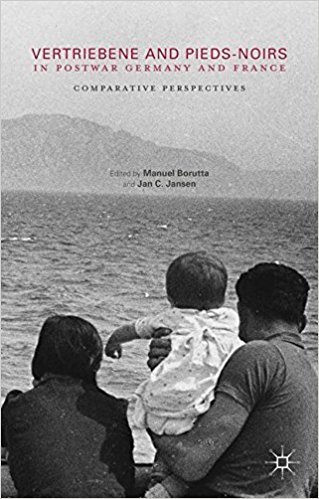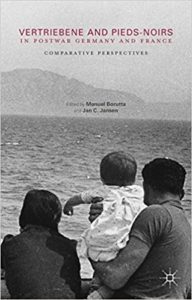
Vertriebene and Pieds-Noirs in Postwar Germany and France: Comparative Perspectives edited by Manuel Borutta and Jan C. Jansen
 As Europe continues to face the largest wave of refugees pouring into its borders since World War II, past influxes of migrants across the continent offer important lessons about national identity and integration. With Germany receiving the vast majority of refugees, and France ranked in the top three destinations, Vertriebene and Pieds-Noirs in Postwar Germany and France is particularly timely. The goal of this book is to compare how the estimated 12 million expellees from Germany’s European Empire were reintegrated within Germany’s shrunken borders after World War II, and how France’s nearly 1 million colonial citizens of Algeria were received in France after Algerian Independence was recognized in 1962. Both the expellees and the Pieds-Noirs were full-fledged citizens who had been fulfilling a national duty for their motherland in its outlying territories. However, when the borders shifted with the fall of the German Empire, and Algeria became independent from France, notions of colonial grandeur waned and died. How the motherland dealt with these living reminders of a failed mission had to fit carefully within the myths of the nation, both present and past. For Germany, this was complicated by the two Germanies, East and West. Where expellees decided to resettle impacted directly on how they would be reintegrated. France, trying to hush up its colonial failures, wilfully silenced the war story, leaving the Pieds-Noirs struggling to share their experience as they banded together in a newly homogenised community. Some quietly integrated, but many today still proudly strive to keep their memories of Algeria alive. Both Vertriebene and Pieds-Noirs have negotiated national ideas of victimization and forgetting, silencing, integrating, and assimilating back into their so-called homeland.
As Europe continues to face the largest wave of refugees pouring into its borders since World War II, past influxes of migrants across the continent offer important lessons about national identity and integration. With Germany receiving the vast majority of refugees, and France ranked in the top three destinations, Vertriebene and Pieds-Noirs in Postwar Germany and France is particularly timely. The goal of this book is to compare how the estimated 12 million expellees from Germany’s European Empire were reintegrated within Germany’s shrunken borders after World War II, and how France’s nearly 1 million colonial citizens of Algeria were received in France after Algerian Independence was recognized in 1962. Both the expellees and the Pieds-Noirs were full-fledged citizens who had been fulfilling a national duty for their motherland in its outlying territories. However, when the borders shifted with the fall of the German Empire, and Algeria became independent from France, notions of colonial grandeur waned and died. How the motherland dealt with these living reminders of a failed mission had to fit carefully within the myths of the nation, both present and past. For Germany, this was complicated by the two Germanies, East and West. Where expellees decided to resettle impacted directly on how they would be reintegrated. France, trying to hush up its colonial failures, wilfully silenced the war story, leaving the Pieds-Noirs struggling to share their experience as they banded together in a newly homogenised community. Some quietly integrated, but many today still proudly strive to keep their memories of Algeria alive. Both Vertriebene and Pieds-Noirs have negotiated national ideas of victimization and forgetting, silencing, integrating, and assimilating back into their so-called homeland.
The two populations shared various challenges, one being that unlike “repatriates,” many had never before set foot in the homeland, and some spoke different languages altogether (Polish, for example among the expellees or Spanish for many Pieds-Noirs). For the Pieds-Noirs who had been implanted in the settler-colony of Algeria for more than 130 years, they were distinct from the French because of their diverse heritages (Spanish, Italian, Maltese, Jewish and even German communities existed in colonial Algeria, all made citizens of France) and their specific cultural backgrounds. The expellees, running counter to this ethnic diversity, were part of a program meant to create homogenous communities abroad. Nonetheless, when “returned” to the motherland, it was not immediately obvious how to integrate these representatives of unsuccessful expansion.
In Vertriebene and Pieds-Noirs, the editors Manuel Borutta and Jan C. Jansen draw useful comparisons between the German expellees post World War II (Vertriebene) and the former French citizens of Algeria who repatriated to France in 1962. The book’s pretext is compelling: these two groups carried a similar amount of stigma related to lost territories during eras of expansion; the two groups represent a large postcolonial diaspora that have not often been addressed because of the sense of “homecoming” involved in their returns to Germany and France respectively. Pieds-Noirs and Vertriebene, in many instances, had to quickly take what they could and flee to the motherland. The trauma of this exile was not easily mitigated because it was often not addressed. With losses pinned to their identities and unfavorable political sins enmeshed in their existence, both groups (responsible or not for these sins) went through difficult integration into the motherland even when support was offered.
The editors have gathered research from the most prominent scholars in their fields: Jansen, Savarèse, Shepard, Baussant and Eldridge, have long been studying the Pieds-Noirs and the memory of the Algerian War, and are each suited to provide authoritative commentary. Likewise, Baranowski, Bösch, François, and Troebst are highly regarded scholars in German studies. Borutta and Jansen have equally established a clear and pedagogically sound structure for their book by pairing studies focused on Germany and France on roughly the same topics: nation-building after the empire, repatriation and integration, community organization and identity, commemorative practices, and politics, and remembrance. Each of the six parts of the book builds on the previous section, which manages to bring even the uninformed reader up to level through the progression of articles. The book represents a vast array of topics ranging from culturally specific Vertriebene culinary practices to Pied-Noir pilgrimages in France, from economic plans for resettlement and reintegration to the place of memory in each community.
Each of the articles are supremely researched, compelling, and enjoyable to read. I read from the position of knowing a lot about the Pieds-Noirs but almost nothing about the Vertriebene. Articles on both topics are clear and engaging for the newcomer and expert alike. For example, the first chapter, “Legacies of Lebenstraum: German Identity and Multi-Ethnicity” by Shelley Baranowski, clearly situates the Vertriebene within German histories of migration and follows them through the histories of both East and West Germany (and the flux between the two) as well as post-unification. This is an eloquent article that is delightful to read. The paired chapter by Todd Shepard, “The Birth of the Hexagon,” offers thoughtful insight on the position of the Pieds-Noirs across history (and their near disappearance in seminal works like Pierre Nora’s Les Lieux de mémoire) and how the community has been positioned in broader notions of French national identity. The conclusion of the book written by Etienne François relates the memories of exile on a personal level. François recounts his family’s unique position of being attached to both Algeria and Germany before the fall of the empires. He sensitively compares the similarities and differences as well as the impact of exile and the traumatic context of departure, on these two communities.
This book provides a rich comparative study, the first of its kind, and certainly the first in English (featuring four French articles that were superbly translated by John Tittensor) to address two lesser known populations of migrants who had and continue to have an important role in the national identities of France and Germany. Specialists in migration studies, diaspora and memory studies, as well as the unversed in the history of the Pieds-Noirs and Vertriebene, will find this book useful. It is clearly and cogently written so that both scholars and general readers will gain insight from the texts and perhaps also better understand the complexities and suffering associated with exile and integration even for those who are said to be coming home.
Reviewed by Amy L. Hubbell, University of Queensland
Vertriebene and Pieds-Noirs in Postwar Germany and France: Comparative Perspectives
Edited by Manuel Borutta and Jan C. Jansen
Publisher: Palgrave Macmillan
Hardcover / 300 pages / 2016
ISBN: 9781137508409
To read more book reviews, please click here.
Published on April 4, 2017.




